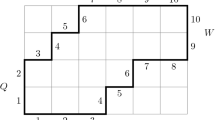Abstract
One of the main open problems in secret sharing is the characterization of the access structures of ideal secret sharing schemes. Brickell and Davenport proved that every one of these ideal access structures is related in a certain way to a unique matroid. Specifically, they are matroid ports. In addition to the search of general results, this difficult open problem has been studied in previous works for several families of access structures. In this paper we do the same for access structures with rank 3, that is, structures whose minimal qualified subsets have at most three participants. We completely characterize and classify the rank-3 access structures that are matroid ports. We prove that all access structures with rank three that are ports of matroids greater than 3 are ideal. After the results in this paper, the only open problem in the characterization of the ideal access structures with rank three is to characterize the rank-3 matroids that can be represented by an ideal secret sharing scheme.
Similar content being viewed by others
References
Beimel A., Tassa T., Weinreb E.: Characterizing ideal weighted threshold secret sharing. In: Second Theory of Cryptography Conference, TCC 2005. Lecture Notes in Computer Science, vol. 3378, pp. 600–619 (2005).
Benaloh J., Leichter J.: Generalized secret sharing and monotone functions. In: Advances in Cryptology, CRYPTO’88. Lecture Notes in Computer Science, vol. 403, pp. 27–35 (1990).
Blakley G.R.: Safeguarding cryptographic keys. AFIPS Conf. Proc. 48, 313–317 (1979)
Blundo C., De Santis A., De Simone R., Vaccaro U.: Tight bounds on the information rate of secret sharing schemes. Des. Codes Cryptogr. 11, 107–122 (1997)
Blundo C., De Santis A., Gargano L., Vaccaro U.: On the information rate of secret sharing schemes. In: Advances in Cryptology - CRYPTO’92. Lecture Notes in Computer Science, vol. 740, pp. 148–167 (1993).
Brickell E.F.: Some ideal secret sharing schemes. J. Combin. Math. Combin. Comput. 9, 105–113 (1989)
Brickell E.F., Davenport D.M.: On the classification of ideal secret sharing schemes. J. Cryptol. 4, 123–134 (1991)
Capocelli R.M., De Santis A., Gargano L., Vaccaro U.: On the size of shares of secret sharing schemes. J. Cryptol. 6, 157–168 (1993)
Csirmaz L.: The size of a share must be large. J. Cryptol. 10, 223–231 (1997)
Farràs O., Martí-Farré J., Padró C.: Ideal multipartite secret sharing schemes. In: Advances in Cryptology, Eurocrypt 2007. Lecture Notes in Computer Science, vol. 4515, pp. 448–465 (2007).
Ito M., Saito A., Nishizeki T.: Secret sharing scheme realizing general access structure. Electron. Comm. Japan Part III Fund. Electron. Sci. 72, 56–63 (1989)
Jackson W.-A., Martin K.M.: Perfect secret sharing schemes on five participants. Des. Codes Cryptogr. 9, 267–286 (1996)
Karnin E.D., Greene J.W., Hellman M.E.: On secret sharing systems. IEEE Trans. Inform. Theory. 29, 35–41 (1983)
Lehman A.: A solution of the Shannon switching game. J. Soc. Ind. Appl. Math. 12, 687–725 (1964)
Lehman A.: Matroids and ports. Notices Amer. Math. Soc. 12, 356–360 (1976)
Martí-Farré J., Padró C.: Secret sharing schemes on sparse homogeneous access structures with rank three. Electron. J. Combin. 11(1), Research Paper 72, 16 pp. (electronic) (2004).
Martí-Farré J., Padró C.: Secret sharing schemes with three or four minimal qualified subsets. Des. Codes Cryptogr. 34, 17–34 (2005)
Martí-Farré J., Padró C.: Secret sharing schemes on access structures with intersection number equal to one. Discrete Appl. Math. 154, 552–563 (2006)
Martí-Farré J.: A note on secret sharing schemes with three homogeneous access structure. Inform. Process. Lett. 102, 133–137 (2007)
Martí-Farré J., Padró C.: On secret sharing schemes, matroids and polymatroids. In: Fourth IACR Theory of Cryptography Conference TCC 2007. Lecture Notes in Computer Science, vol. 4392, pp. 273–290 (2007).
Matúš F.: Matroid representations by partitions. Discrete Math. 203, 169–194 (1999)
Oxley J.G.: Matroid Theory. Oxford Science Publications. The Clarendon Press, Oxford University Press, New York (1992)
Padró C., Sáez G.: Secret sharing schemes with bipartite access structure. IEEE Trans. Inform. Theory 46, 2596–2604 (2000)
Seymour P.D.: A forbidden minor characterization of matroid ports. Quart. J. Math. Oxford Ser. 27, 407–413 (1976)
Seymour P.D.: On secret-sharing matroids. J. Combin. Theory Ser. B 56, 69–73 (1992)
Shamir A.: How to share a secret. Commun. ACM 22, 612–613 (1979)
Simonis J., Ashikhmin A.: Almost affine codes. Des. Codes Cryptogr. 14, 179–197 (1998)
Stinson D.R.: An explication of secret sharing schemes. Des. Codes Cryptogr. 2, 357–390 (1992)
Welsh D.J.A.: Matroid Theory. Academic Press, London (1976)
Author information
Authors and Affiliations
Corresponding author
Additional information
Communicated by H. Wang.
A previous version of this paper appeared in Fifth Conference on Security and Cryptography for Networks, SCN 2006, Lecture Notes in Computer Science 4116 (2006) 201–215.
Rights and permissions
About this article
Cite this article
Martí-Farré, J., Padró, C. Ideal secret sharing schemes whose minimal qualified subsets have at most three participants. Des. Codes Cryptogr. 52, 1–14 (2009). https://doi.org/10.1007/s10623-008-9264-9
Received:
Revised:
Accepted:
Published:
Issue Date:
DOI: https://doi.org/10.1007/s10623-008-9264-9




